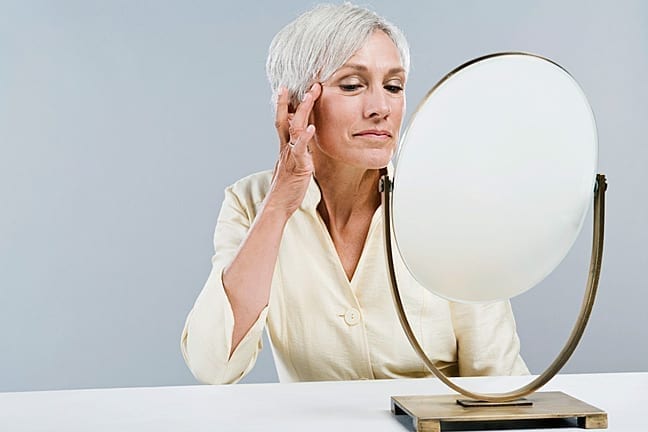Most of us can spot good skin a mile away.We can instantly identify the characteristics of healthy, beautiful skin. It’s well hydrated, tight and elastic, not overly oily, with clear pores.
QUIZ: Do You Have Healthy Skin?
Here’s the big skin myth—you can stop your skin from aging. No matter what products and procedures you undergo, you can’t stop the pulling, tugging and sagging of your skin over time. You can, however, slow down these effects and encourage healthier skin.Skin aging can happen in the matrix between cells, within the dermis or on the surface.
Here’s how:
In the matrix: Skin aging happens when collagen is damaged and loses its tight weave, so your elastin loses its zing. The fibroblasts (and their DNA) that produce collagen and elastin are prone to UV radiation damage. As they falter, that DNA makes less and/or defective collagen or elastin.Also, glycosaminoglycans are large sugar-like molecules that plump and fill the skin when they bind with water. As you age, they become less effective and don’t suck up water as efficiently. This decrease in water means that the skin becomes dull and dry. These older glycosaminoglycans can link up with proteins and cause yellowing (or browning) of the skin, a process called glycation. Though it happens in all of us, it’s especially apparent in diabetics.
Research: Sun-damaged Skin Looks Older
On the surface: Your skin secretes fat (lipids). Fatty acids called ceramides protect the outermost layer of your skin, the stratum corneum. The ceramides ensure your skin is hydrated and less susceptible to irritation.Think of these fatty acids as a protective coating. Ceramide concentrations reduce with aging and when you wash your face and body with fat emulsifiers like soap and alcohol. Our mantra isn’t “use just water” if you touch dirty objects or people, but washing with just water helps save those ceramides.
How skin ages: Thinner, duller, less vibrant skin is what you expect as you get older, but you can control how fast these changes happen. In your 40s, skin becomes thinner and more translucent, so capillaries show. Visible capillaries will also increase from years of sun exposure.Photoaging signs—wrinkles, age spots, uneven pigmentation—may develop, especially if you weren’t diligent about sun protection from childhood into your 30s. Your skin produces less oil in your 40s, leading to dryness, plus cell turnover is slower, which dulls your appearance.
In your 50s, you may experience deepening facial lines and wrinkles, due to the loss of subcutaneous fat and moisture (and as usual, sun damage). When skin elasticity decreases, your skin slackens, particularly around the jaw line and eyes. If you’re postmenopausal, the drop in estrogen can make your skin thinner, dryer and more irritated.
WATCH VIDEO: How Your Skin AgesRich moisturizers will decrease water loss, but may lead to unnecessary dependence on them. Vitamin A and E creams increase your skin’s water content. Regular exfoliation is a good addition to your routine, which will slough any dry, rough patches on the epidermis.
If you’re typical, from your 60s to your 90s, cell turnover and skin healing will become even slower. Your skin may be very dry too. Mature skin may need special care, including hydrating moisturizers and regular exfoliation to prompt cell turnover.




































